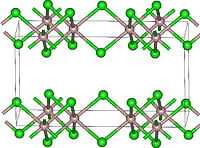Lutetium(III) chloride
From Wikipedia, the free encyclopedia
| Lutetium(III) chloride | |
|---|---|
 | |
| IUPAC name Lutetium(III) chloride | |
| Other names Lutetium chloride, lutetium trichloride | |
| Identifiers | |
| CAS number | 10099-66-8 |
| PubChem | 24919 |
| ChemSpider | 23297 |
| RTECS number | OK8400000 |
| Jmol-3D images | {{#if:Cl[Lu](Cl)Cl|Image 1 |
| |
| |
| Properties | |
| Molecular formula | LuCl3 |
| Molar mass | 281.325 g/mol |
| Appearance | colorless or white monoclinic crystals |
| Density | 3.98 g/cm³ |
| Melting point | 905°C[1] |
| Boiling point | sublimes above 750°C[2] |
| Solubility in water | soluble[3] |
| Structure | |
| Crystal structure | Monoclinic, mS16 |
| Space group | C2/m, No. 12 |
| Hazards | |
| R-phrases | R36/37/38 |
| S-phrases | S26, S36[4] |
| Main hazards | Xi (Irritant) |
| NFPA 704 |
 0
2
1
|
| Related compounds | |
| Other anions | Lutetium(III) oxide |
| Other cations | Scandium(III) chloride Yttrium(III) chloride |
| Except where noted otherwise, data are given for materials in their standard state (at 25 °C (77 °F), 100 kPa) | |
| Infobox references | |
Lutetium(III) chloride or lutetium trichloride is the chemical compound composed of lutetium and chlorine with the formula LuCl3. It forms hygroscopic white monoclinic crystals.[1] Lutetium(III) chloride has the YCl3 (AlCl3) layer structure with octahedral lutetium ions.[5]
Reactions
Pure lutetium metal can be produced from lutetium(III) chloride by heating it together with elemental calcium: [6]
References
- ↑ 1.0 1.1 Lide, David R. (1998), Handbook of Chemistry and Physics (87 ed.), Boca Raton, FL: CRC Press, p. 472, ISBN 0-8493-0594-2, retrieved 2008-06-27
- ↑ "Chemistry: Periodic Table: Lutetium: compound data (lutetium (III) chloride)". WebElements. Retrieved 2008-06-27.
- ↑ Perry, Dale L.; Phillips, Sidney L. (1995), Handbook of Inorganic Compounds, CRC Press, p. 232, ISBN 0-8493-8671-3, retrieved 2008-06-27
- ↑ "450960 Lutetium(III) chloride anhydrous, powder, 99.99% trace metals basis". Sigma-Aldrich. Retrieved 2008-06-27.
- ↑ Wells A.F. (1984) Structural Inorganic Chemistry 5th edition Oxford Science Publications ISBN 0-19-855370-6
- ↑ Patnaik, Pradyot (2004), Handbook of Inorganic Chemicals, Amsterdam: McGraw-Hill Professional, p. 244, ISBN 0-07-049439-8, retrieved 2008-06-27
| |||||
This article is issued from Wikipedia. The text is available under the Creative Commons Attribution/Share Alike; additional terms may apply for the media files.